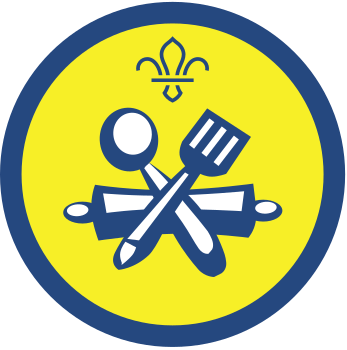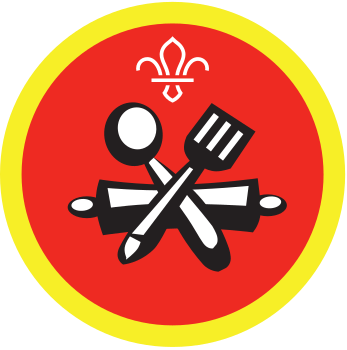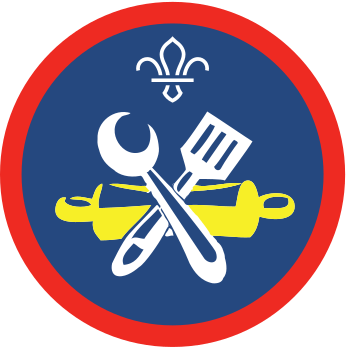
Make Mtabaq from Jerusalem
You’ll need
- Ingredients (see recipe)
- Large baking tray
- Two large saucepans
- Pastry brush
- Greaseproof paper
- Weighing scale
- Access to oven
- Access to sink
- Heat protective equipment, such as heatproof gloves and mat.
- Tea towels
- Chopping board
- Plates (one each)
- Knife
- Measuring jug
- Wooden spoons
- Tablespoons
- First aid kit, including for burns
- Washing up liquid
- A way to put a fire out, such as fire extinguisher
Before you begin
- Use the safety checklist to help you plan and risk assess your activity. There's also more guidance to help you carry out your risk assessment, including examples.
- Make sure all young people and adults involved in the activity know how to take part safely.
- Make sure you’ll have enough adult helpers. You may need some parents and carers to help.
- Remember to check for allergies, eating problems or dietary requirements and adjust the recipe as needed. Make sure you've checked everyone's dietary requirements and allergies then adapted the recipe as appropriate. This may include ensuring no cross-contamination during food preparation, too.
- Check if there are any items of food (or packaging) that people can’t touch or be near to or if there are items that people might not be comfortable using in the activity.
- Some people may not like certain food textures or tastes and that’s OK. Try to find an alternative for them. No-one has to use all the ingredients or be made to try foods if they’re not happy, comfortable or don’t want to.
- Remember to have a hand washing station and take extra hygiene precautions when handling food.
- Take a look at our guidance on food preparation.
- Make sure you have all the ingredients ready.
- You may want to run a kitchen safety talk and show people how to use the equipment safely, such as for cooking or chopping ingredients. You could run our kitchen safety and hygiene activities, Kitchen risk bingo and Home kitchen hygiene prior to running this session.
- If you’re using a gas stove, make sure it’s on a stable heatproof surface and in a clear and open area, with plenty of ventilation. Gas can increase risk of carbon monoxide exposure. We have more guidance on different cooking methods.
- Depending on your meeting place, you may wish for groups to make or prepare the ingredients in a wider, more spacious area, then invite each group into the kitchen to cook one at a time. Remember the groups not using the kitchen or cooking will still need to be supervised, always following the Yellow Card.
Sweet Cheese Pastry Parcels Recipe
Ingredients serves 4-6
- 90g of melted salted butter
- Thawed filo pastry or puff pastry
- 500g ricotta with 200g grated mozzarella cheese
- 20g crushed pistachios (optional)
- 260g caster sugar
- 3 cardamom pods
- 1 tablespoon lemon juice
- 1 teaspoon orange blossom water (optional)
- Plain flour for dusting plates while making parcels
Cook Time
Prep time: 60 mins
Cook time: 15 mins
Setting up this activity
- Preheat the oven to either 180° C for a fan oven or Gas Mark 6.
- Put out any tables you might use, along with ingredients, copies of the recipe and equipment.
- Thawed filo or puff pastry must be covered with a clean damp tea towel to stop it drying out. Cut the pastry into 4 squares and cover with clean damp tea towel.
- You should use either 1 sheet of filo pastry or 1 roll of ready roll puff pastry. Each sheet will be cut up in to 4 portions. Everyone should get either 2 squares of filo or 1 square of puff pastry.
- Make sure there’s a responsible adult to manage the cooking sources, such as the oven and hob. This should be separate to people who are supervising young people or leading other activities. You can restrict access to the kitchen or cooking source to one group at a time, while everyone else prepares their ingredients in another supervised area. Always follow the Yellow Card.
Run the activity
- Gather everyone together and tell them you’re going to be making mtabaq, a sweet cheese filled pastry parcel which is served in bakeries and cafes in Jerusalem. Mtabaq (m’tabaq or m’tabbak) means ‘folded’ in Arabic. Mtabaq is very often found in bakeries and café’s in Jerusalem, as well as many other parts of the Middle East. These can be made with filo or puff pastry, and they’re filled with cheese and covered with sugar syrup. Traditionally, Akkawi cheese is used, which can be bought from Middle Eastern stores. However, you can use ricotta mixed with mozzarella to make them too.
- Ask everyone to wash their hands, then get into pairs or small groups. Each group should collect the ingredients and equipment, then find a space. You may want to provide printed copies of the recipe.
- To make the syrup, in a separate pan, add the water and sugar. With an adult’s help and supervision, heat it on the hob over medium heat. Stir it with wooden spoon, either bringing it to boil or until the sugar’s been fully dissolved.
- When the sugar’s dissolved, or the mix has been brought to the boil, add one tablespoon of lemon juice, then mix well. You may wish to add one teaspoon of orange blossom water, but this is optional.
- In a large bowl, someone should mix the ricotta cheese and the mozzarella cheese together, using a spoon.
- Everyone should lightly dust their plates with flour, then take the squares of pastry they need and place them on the plate. You should use either two square of Filo pastry or one square of puff pastry per person.
- Everyone should place two large tablespoons of the cheese mixture into the middle of the pastry square, then spread the mixture around with the back of the spoon or your fingers. You should leave a 5cm gap between the cheese and the edge of the pastry.
- Fold the four corners of the pastry over, so the tips meet in the middle of the square. Gently press down on the pastry edges to seal the cheese in.
- Someone should cut pieces of greaseproof paper to the size of the baking trays, then place the paper on the baking trays.
- Place the pastry parcel gently on top of the greaseproof paper on the baking trays. Place it with the seam side facing down.
- An adult volunteer should melt the butter in a pan. Once melted, the melted butter should be left to cool slightly on a heatproof surface to one side and out of reach of young people. Remember to turn the hob off.
- An adult volunteer should brush each parcel with the melted butter.
- Use a knife to cut a small cross in the centre of the parcel.
- An adult should place the trays in the oven and let the parcels bake for around 15 to 20 mins, or until the pastries are a crisp, golden brown.
- Once the pastries are cooked, an adult should carefully remove the trays from the oven, using heatproof protective equipment, such as heatproof gloves. The pastries should be left on a heatproof surface to one side and out of reach of young people. Remember to turn the oven off.
- Once the pastry parcels have cooled, everyone should use a spatula to place their parcel on the plate. They should then spoon two or three tablespoons of the sugar syrup on to the parcel.
- People may want to add crushed pistachio nuts on top of their pastries.
- Once the pastries are cooled, you can try tasting them.
Reflection
This activity gave everyone the opportunity to try something new and work as a team to cook some Mtabaq. Have you made anything similar before? How easy was it to make? What was it like following the recipe? What did it taste like? Did you enjoy it?
You had to work as a team to make the pastry parcels. How did you make sure everyone could be involved? How did you make sure everyone could share and use their skills? Did everyone get to have a turn at the different stages, such as making the syrup?
What was it like folding the pastry? Did you have any problems? If so, how did you solve them? How did you make sure everyone stayed safe too?
If you could put anything inside the pastry parcels, what ingredients would you use? You could use fruits, jam, chocolate or something else.
Safety
All activities must be safely managed. You must complete a thorough risk assessment and take appropriate steps to reduce risk. Use the safety checklist to help you plan and risk assess your activity. Always get approval for the activity, and have suitable supervision and an InTouch process.
- Flammable items
Always take care when using flammable items, especially if you’re near fire. Always follow the manufacturer’s instructions and guidelines.
- Hot items and hot water
Kettles, cookers and microwave ovens produce a lot of heat by the very nature of them. Caution is needed when in contact with items that have been heated and young people should use them under adult supervision. Use on a suitable surface, protecting it if necessary. Never leave hot items unattended and make sure there’s a nearby first aid kit, with items to treat burns/scalds.
- Food
Remember to check for allergies, eating problems, fasting or dietary requirements and adjust the recipe as needed. Make sure you’ve suitable areas for storing and preparing food and avoid cross contamination of different foods. Take a look at our guidance on food safety and hygiene.
- Fires and stoves
Make sure anyone using fires and stoves is doing so safely. Check that the equipment and area are suitable and have plenty of ventilation. Follow the gas safety guidance. Have a safe way to extinguish the fire in an emergency.
- Cooking
Teach young people how to use cooking equipment safely. Supervise them appropriately throughout. Make sure it’s safe to use and follow manufacturers’ guidelines for use.
- Sharp objects
Teach young people how to use sharp objects safely. Supervise them appropriately throughout. Store all sharp objects securely, out of the reach of young people.
- If anyone needs help or struggles with fine motor skills, give them the opportunity to work in pairs or small groups. They could also work with a young leader or an adult volunteer. The person they’re working with can help with the parts they find fiddly to do or tricky.
- If you’re measuring out ingredients, anyone who struggles with maths can partner up with or join a group with someone who’s more confident at the measuring part of this activity. Alternatively, a young leader or adult could support them in the measuring part of this activity.
- Remember, some baking and cooking activities can be done either sitting or standing – people can choose whichever way is best for them. People could work with a partner, with one taking on any standing tasks and the other doing tasks seated.
- Some people may not like certain food textures or tastes and that’s OK. Try to find an alternative for them. For example, they may want to make a fruit, jam or chocolate spread pastry. No-one has to use all the ingredients or be made to try foods if they’re not happy, comfortable or don’t want to, and no-one should be forced to try a food when they don’t want to. Check if there are any items of food (or packaging) that people can’t touch or be near to, or if there are items that people might not be comfortable using in the activity.
- There are lots of loud noises and different smells in a kitchen or while cooking, which may overwhelm some people. People may choose to wear ear defenders while in the kitchen, take a break from the activity or prefer to stay a distance away from the activity and that’s OK. You could use fragrance free soap or washing up liquid or have items pre-chopped to reduce noise. You might also want to keep any blending, electric whisks or noisier equipment to being used in one room and shut the door, so people have an option to step out if it’s too loud. Check before and during the activity that everyone is comfortable, and make sure everyone knows that they can leave the activity at any point. It might be useful to agree a signal people can use, such as raising their hand, to stop take a break for the activity or if they need to speak to an adult.
Make it accessible
All Scout activities should be inclusive and accessible.



